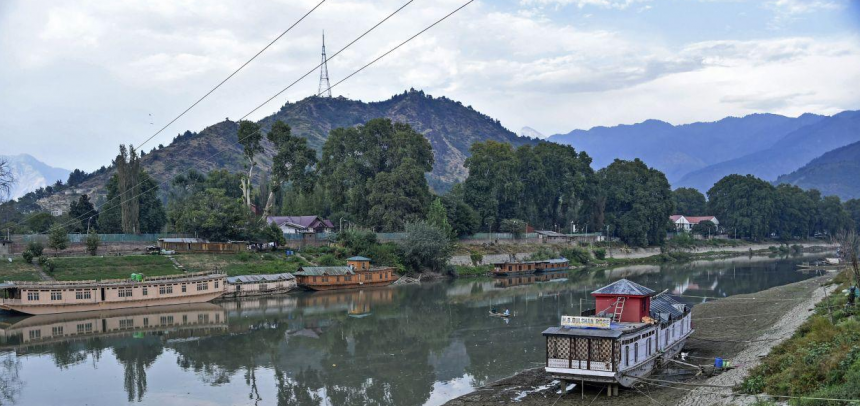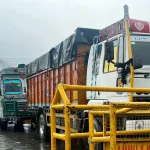PARCHED VALLEY
As heat waves sweep across the Kashmir Valley, the picturesque landscape is confronting a harsh environmental crisis. Once-abundant streams and rivulets that nourished generations of rice farmers now lie cracked and dry. For the agrarian communities in Kashmir, especially those reliant on paddy cultivation, the consequences are profound. The ongoing climate extremes have exposed the unpreparedness of administrative institutions and triggered a policy debate on whether paddy sowing should be restricted in far-flung areas disconnected from irrigation sources.
This article delves into the severity of the heat wave and its impact on the Valley’s water bodies, evaluates the administrative responsibilities of the Revenue, Irrigation, and Jal Shakti departments, and assesses whether a calibrated approach—such as disallowing paddy sowing in water-scarce zones—is necessary to avoid a looming agricultural and hydrological disaster.
Heat Wave Phenomenon in Kashmir: A New Climatic Reality
Until recently, the word ‘heat wave’ was not part of the local vocabulary in Kashmir. Traditionally known for its moderate summers, the Valley has in recent years witnessed a worrying shift in weather patterns. The Indian Meteorological Department (IMD) recently classified temperatures across south and central Kashmir as “severe heatwave conditions,” with mercury levels crossing 35°C in many districts—an anomaly for May and June.
According to environmental experts, this is no isolated event. A combination of global climate change, rapid deforestation, and unregulated urban sprawl has caused a steady increase in average summer temperatures across the Valley over the past two decades. Evaporation rates have increased dramatically, shrinking water levels in springs, karewas, nullahs, and even major rivers like the Jhelum.
Dried Water Bodies: Shrinking Lifelines of Agriculture
Kashmir’s agrarian economy is historically dependent on an intricate natural and man-made irrigation system involving streams, canals (kul), and traditional water channels. This system is deeply sensitive to rainfall, snowmelt, and the maintenance of water bodies.
Key Observations
- Springs and Karewas Drying Up: Many perennial springs in Anantnag, Kulgam, and Pulwama districts have gone dry. Karewa lands that stored water under soft soils have become hard and impermeable.
- Depleting Groundwater: Bore wells and hand pumps in rural belts are running dry weeks earlier than usual. Recharge rates are negligible due to vanishing catchment areas.
- Silted Canals: Irrigation canals remain clogged with silt and plastic waste, obstructing even the reduced flow from upstream sources.
- Low River Discharge: The Jhelum and its tributaries like the Lidder and Vaishaw have recorded their lowest discharge levels in decades.
Agricultural Consequences: Paddy Cultivation under Threat
Paddy, the staple crop of the Valley, is a water-guzzling crop that demands continuous flooding during its transplanting and early growth stages. Historically, paddy fields were laid near streams or canals, but over time, cultivation spread into distant uplands as water infrastructure expanded.
Challenges Today
- No Water for Transplantation: In areas like Qazigund, Pahalgam belt, Khansahib, and parts of Sopore, farmers are reporting failure to transplant paddy due to completely dry khuls and fields.
- Crop Failure Risk: Early transplantation in heat-affected areas is likely to suffer yield collapse due to water stress and soil salinization.
- Competition for Scarce Water: Tube wells installed to irrigate paddy fields now serve drinking water needs of entire villages, making agricultural use unviable.
- Debt and Desperation: Many peasants have borrowed money expecting a normal season. With no water, they face financial ruin.
Institutional Accountability: What Should the Government Do?
Kashmir’s environmental stress is not just a natural calamity; it is a reflection of administrative inertia. The Revenue, Irrigation, and Jal Shakti departments must step in with data-driven decisions and immediate actions.
- Revenue Department
The revenue officials including Patwaris, Girdawars, and Tehsildars must:
- Conduct Ground-Level Surveys: Verify fields where water is unavailable for paddy cultivation.
- Mark Ineligible Paddy Areas: Prepare a map of fields unsuitable for paddy due to distance or absence of water source.
- Coordinate with Agriculture and Irrigation Departments: Ensure that policy restrictions are practically applicable on-ground.
- Irrigation & Flood Control Department
- Desilt Irrigation Channels: Emergency clearance of primary and secondary canals to improve whatever water flow is left.
- Introduce Temporary Lifting Systems: Portable pump-based solutions to transfer water from low-lying rivers to dry fields should be evaluated.
- Monitor Water Flow Digitally: Use drones or sensors to identify blockages and optimize distribution.
- Jal Shakti Department
- Prioritize Drinking Water: Ensure that drinking needs override all agricultural use.
- Launch Water Rationing Plan: Allocate irrigation on rotation, giving priority to villages near natural sources.
- Public Awareness Drives: Educate farmers on climate-adapted cropping patterns and discourage high-water crops during heat waves.
Should Paddy Sowing Be Banned in Distant, Waterless Fields?
This is the hardest policy question administrators face. Should the UT step in and disallow paddy sowing in fields where water cannot reach naturally or affordably?
Yes and Here’s Why:
- Water Misallocation: Allowing distant paddy fields puts pressure on common water sources, affecting everyone’s share.
- Environmental Degradation: Desperate digging of borewells and pumping water to far-off fields is depleting groundwater.
- Economic Losses: Crops fail mid-season due to drying khuls, leading to wasted labor, seeds, fertilizers, and debt traps.
- Conflict Triggers: Water disputes between villages or communities are already being reported—this will intensify without regulation.
What Should Replace Paddy in These Areas?
- Low Water Crops: Pulses, maize, or vegetables that require minimal irrigation.
- Drought-Resistant Varieties: Research institutes like SKUAST should introduce climate-resilient paddy strains.
- Agroforestry and Fodder Crops: Can support cattle rearing while restoring soil health.
A Policy Blueprint for the Administration
- Declare Water-Scarce Zones: Based on surveys and satellite imagery, certain blocks should be marked as “non-paddy zones” until water levels normalize.
- Issue Temporary Cultivation Bans: Through notifications under the Land Revenue Act and Disaster Management Act.
- Compensate Farmers: Offer compensation or input support for farmers who voluntarily skip paddy this season.
- Long-Term Irrigation Planning: Build water storage reservoirs and ponds in each tehsil as a climate adaptation measure.
Legal Tools Available
- Section 144 CrPC: Can be invoked to prevent illegal water usage or paddy sowing in banned areas.
- Land Revenue Rules: Permit Tehsildars to regulate seasonal crop choices during ecological emergencies.
- Disaster Management Act: Provides sweeping powers to departments for issuing preventive agricultural orders during extreme weather events.
The Way Forward: Sustainability over Sentiment
While paddy is embedded in the Kashmiri way of life, its cultivation cannot continue unchecked under climate-stressed conditions. A balance must be struck between tradition and survival.
- Ban paddy in far-off, un-irrigated fields this year.
- Desilt canals, prioritize near-source agriculture.
- Offer subsidies for alternative crops.
- Train Patwaris and officials in climate monitoring.
- Hold officers accountable for inaction.
This is not merely an environmental issue—it is an agricultural, economic, and human rights crisis. And like any crisis, it must be met with courage, data, and empathy.
(Author is a legal columnist and researcher based in Kashmir, focusing on land governance, environmental law, and administrative reforms. Feedback at: [email protected])








